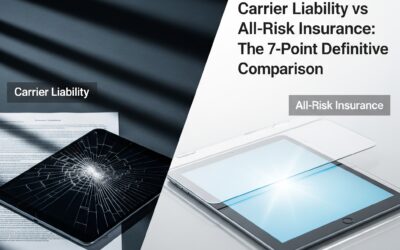The Anatomy of a Shipping Insurance Claim: A Complete Guide
For any business, purchasing shipping insurance is an act of trust. You invest in a promise—a promise that if something goes wrong, your partner will be there to make things right. But with shipping insurance, that promise is put to the test far more often than with other policies. In the fast-paced, often chaotic world of logistics, a damaged or lost package is an unfortunate, but regular, cost of doing business.
This is what we call the “moment of truth.” It’s the instant you file a shipping insurance claim, and it’s the moment the true character of your insurance provider is revealed.
Will it be a simple, collaborative process designed to get you paid quickly? Or will it be a frustrating maze of paperwork, long delays, and an adversarial tone that makes you feel like you’re the one on trial?
The anxiety around the claims process is the single biggest reason many businesses are hesitant about shipping insurance. They’ve been burned before by the runaround from carriers or by traditional shipping insurance models that feel designed to reject, not resolve.
We believe that a great shipping insurance claim process shouldn’t be a secret. It should be transparent, predictable, and fair. This guide will pull back the curtain entirely. We will walk you through the anatomy of a claim, step-by-step, from the moment you discover a problem to the moment the funds are in your account. By the end, you will not only understand how to navigate the process but also know exactly what to look for in a partner you can truly trust.
Part 1: Before the Claim – How to Build Your “Claims Preparedness Kit”
The easiest shipping insurance claim is one that’s prepared for before the package ever leaves your door. A few simple, proactive habits can transform a potentially stressful situation into a smooth and simple administrative task. Top-tier businesses don’t just react to problems; they build systems to handle them efficiently. Think of this as creating your business’s “Claims Preparedness Kit.”
The Golden Rule: Documentation Is Your Best Defence
In any claim, clear documentation is undeniable proof. Your goal is to create a clear, chronological story of your shipment’s value and condition before, during, and after its journey. An organized digital folder for each shipment is a professional best practice for shipping insurance.
- Proof of Value is Non-Negotiable: Always have a digital copy of the commercial invoice or customer receipt for the item you are shipping. This is the primary document used to establish the financial value of your claim. Without it, the insurer has no verifiable way of knowing the item’s worth. Make it a habit to save a PDF of the invoice to a cloud folder (like Google Drive or Dropbox) titled with the order number at the time of sale.
- Proof of Shipment: This is your shipping label and the tracking information. It proves that the package was tendered to the carrier and establishes the timeline of its movement through the logistics network. A screenshot of the final tracking confirmation can also be valuable.
- The Power of Pre-Shipment Photos: For high-value (over $500), fragile, or custom items, getting into the habit of taking a quick photo of the item inside its packaging before you seal the box is an incredibly powerful tool. It preemptively counters any potential argument that the item was improperly packed. This simple, 10-second step can eliminate days of back-and-forth during a damaged shipment claim.
- Keep Original Packaging (When Damaged): This is a crucial instruction for your customer. If a customer reports damage, instruct them to keep all original packaging until the claim is resolved. Photos of the box itself—showing dents, tears, or water damage—are crucial evidence that the damage occurred in transit. A crushed corner on a box directly corresponds to the dent on the product inside, telling a clear story.
Create a Professional, Customer-Facing Protocol
Your customer is your most important partner in a successful claim. When a customer receives a damaged item, they are upset and looking to you for a solution. A clear, empathetic, and professional process turns a negative experience into an opportunity to build loyalty.
- Act with Urgency: Instruct customers to contact you within 24-48 hours of receiving a damaged package. The sooner the claim is initiated, the better. Have a dedicated, easy-to-find email address or contact form on your website for “Shipping Issues.”
- Create a “Photo Guide” for Customers: Don’t just ask for photos; guide them. Create a simple template email or a page on your website that kindly asks for specific shots:
- A photo of the outside of the box, showing any damage.
- A photo of the inside of the box, showing the cushioning.
- A photo of the damaged item itself from multiple angles. Making this request standard practice normalizes the process and ensures you get the high-quality evidence you need to successfully file the shipping insurance claim.
- Reassure, Reassure, Reassure: Use empathetic language. Acknowledge their disappointment. Let the customer know you will handle the shipping insurance claim and that you will take care of them with either a refund or a replacement. A stressful situation for them is a chance for you to shine with excellent customer service.
By embedding these steps into your workflow, you’re not just preparing for a claim; you’re building a professional, resilient shipping operation that protects your finances and your brand reputation.

Part 2: The Anatomy of a Shipping Insurance Claim – A Step-by-Step Walkthrough
When a package is lost or damaged, a clear process brings order to the chaos. While every provider is slightly different, a well-structured shipping insurance claim process follows five logical steps. Here, we’ll break down each step, explaining what’s happening behind the scenes and contrasting a modern, streamlined approach with the traditional, often-frustrating method.
Step 1: The First Notice of Loss (FNOL)
- What It Is: The FNOL is the official start of the claims process. It’s the moment you formally notify your insurance partner that a shipment has been lost or damaged.
- The ShipSimple Way: A modern claims process begins online. You should be able to log into your shipping platform, find the tracking number in question, and click a button that says “File a Claim.” The system should then guide you through a simple, intuitive form where you provide the basic details: what happened, when you found out, and the value of the item. This can be done 24/7, in minutes, from your phone or computer.
- The Traditional Way: This often involves searching a website for a PDF claim form, downloading it, filling it out manually, scanning it, and emailing it to a generic “claims” email address. You then have to wait, sometimes for days, just to get an acknowledgment that your shipping insurance claim has been received. This initial friction is a major red flag indicating an outdated and likely slow process.
Step 2: Document Submission
- What It Is: This is where you provide the evidence you prepared for in Part 1. Your goal is to upload all the necessary documentation to support your claim.
- The ShipSimple Way: An integrated portal will provide you with a clear checklist of what’s needed and allow you to upload the files directly. For a damaged shipment claim, this would be:
- Proof of Value (Invoice/Receipt)
- Photos of the Damaged Item & Packaging You upload the files, click submit, and receive instant confirmation. The entire submission process can take less than five minutes. The system keeps everything organized under one claim number.
- The Traditional Way: This step often involves a lengthy email chain. You send your initial documents, and a claims adjuster may reply days later asking for more information. This can go back and forth for weeks, with each email exchange adding delays and frustration. It can feel like a game of “fetch,” where you are constantly being asked for one more thing, and documents can get lost in the email shuffle.
Step 3: The Adjudication (Review) Process
- What It Is: Once your documents are submitted, a claims specialist reviews your file. This is the “adjudication” phase.
- Behind the Scenes: The specialist is verifying three key things:
- Is the policy active and was the shipment covered? (A formality).
- Is the loss/damage a covered event? (With all-risk insurance, it almost always is, unless it’s a specific exclusion like improper packaging).
- Is the value of the claim accurate and supported by the invoice?
- The Human Element: Who is your claims specialist? In a traditional model, this person may be part of a large, disconnected department, handling hundreds of claims and incentivized to minimize payouts. In a modern, customer-centric model like ShipSimple’s, the specialist is a dedicated partner. Their goal is to help you successfully close your shipping insurance claim.
- The ShipSimple Way: Our claims specialists are partners, not interrogators. Their goal is to approve your claim. If a document is unclear or missing, they will proactively contact you with a specific, helpful request (e.g., “The photo of the box is a bit blurry, could you please provide a clearer one?”). Communication is clear, transparent, and designed to move the package insurance claim toward resolution quickly. A typical review takes 24-48 business hours.
- The Traditional Way: This is where many claims go to die. The process can be opaque, with little to no communication. The adjuster may be looking for reasons to deny the claim to save the company money, such as trying to prove the packaging was insufficient or that the damage was pre-existing. It can feel adversarial and stressful.
Step 4: The Resolution
- What It Is: This is the official decision on your claim.
- The Three Possible Outcomes:
- Approved: The best-case scenario. The claim is validated, and the payment is processed for the full insured value. This should be the outcome for the vast majority of legitimate claims.
- Request for More Information (RFI): This is not a denial. It simply means the adjuster needs one final piece of information to approve the claim. With a good partner, this is a quick and easy step. For example, they may need a statement from the customer confirming they did not receive the package in a theft case.
- Denial: In a fair system, denials are rare and happen for legitimate, transparent reasons that are clearly outlined in your policy (e.g., shipping a prohibited item, clear evidence of fraud, or demonstrably insufficient packaging for a fragile item). A trustworthy partner will provide a clear written explanation for the denial, referencing the specific part of the policy that applies. They won’t just say “denied”; they’ll explain exactly why.
Step 5: The Payout
- What It Is: The final, and most important, step. Your business is reimbursed for the loss.
- The ShipSimple Way: Once a claim is approved, payment should be processed immediately. We process payments via direct deposit, and the funds are typically in our customer’s account within 24-72 hours of approval. The speed of the payout is critical for a small business’s cash flow, allowing you to refund your customer or ship a replacement without taking a financial hit.
- The Traditional Way: It is not uncommon for businesses to wait 30, 60, or even 90 days to receive a cheque in the mail after a claim has been approved. These delays can put a serious strain on your finances, turning even a successful claim into a frustrating experience that ties up your capital.
Part 3: The ShipSimple Difference – A Claim Process Built on Trust
Understanding the anatomy of a claim is one thing; experiencing a process designed around your needs is another. We architected the ShipSimple shipping insurance claim process to directly address the pain points of the traditional model. Our philosophy is simple: when our customers need us most, we should be at our best.
The Traditional Claims Experience vs. The ShipSimple Claims Experience
| Feature | The Traditional Way | The ShipSimple Way |
|---|---|---|
| Initiation | Download/scan/email PDF forms. Wait days for a reply. | 24/7 online portal. Instant confirmation. Start in minutes. |
| Communication | Slow, opaque email chains. Adversarial tone. | Proactive, clear updates. Collaborative and helpful tone. |
| Speed | Weeks or months from start to finish. | Average resolution time is under 72 hours. |
| Transparency | Black box process. You’re often left guessing the status. | Real-time status tracking in your dashboard. |
| Outcome | Focus can be on finding reasons to deny a claim. | Focus is on finding a way to approve your claim, fast. |
| Support | Disconnected call centre. | Access to dedicated Canadian logistics and insurance experts. |
Export to Sheets
“I used to dread filing a shipping insurance claim. With our old provider, it was a month-long battle of unreturned emails. My first time filing a damaged shipment claim with ShipSimple, I did it from my phone in three minutes before my morning coffee was done. I got a confirmation email instantly and a personal follow-up the next day. The money was in our account two days later. It changed my entire view of what shipping insurance could be.” – A ShipSimple Customer
Frequently Asked Questions About the Shipping Insurance Claim Process
1. How long do I have to file a shipping insurance claim? Most policies require you to file a claim within a specific timeframe, often 60 to 90 days from the date of shipment. However, it’s always best practice to initiate the claim as soon as you are aware of the issue. Prompt reporting demonstrates professionalism and makes the details of the case easier to recall and document.
2. What’s the difference between a shipping insurance claim for damage and a claim for a lost package? A damage claim requires photos and evidence of the damage upon arrival. A lost package claim requires waiting until the package is officially declared lost by the carrier, which usually happens after a certain number of days without a tracking update (typically 7-14 days for domestic shipments). Once it’s declared lost, the claims process is similar, but you provide proof of non-delivery (like a tracking screenshot and customer confirmation) instead of photos of damage.
3. Will my premium go up if I file a claim? Unlike car insurance, your shipping insurance rates are typically based on the value of goods you ship, your shipping volume, and the risk associated with your products and destinations, not on individual claims. Filing legitimate claims should not cause your rates to increase. However, a consistent pattern of high-frequency claims may prompt a partner like ShipSimple to proactively reach out with advice on improving packaging or choosing more reliable shipping lanes to help reduce your overall risk.
4. What happens if a customer claims a package was stolen from their porch? This is a major reason to have all-risk shipping insurance. Most carrier liability ends the moment a package is marked “Delivered.” A good third-party policy will cover porch piracy. The claim will typically require a statement from the customer confirming non-receipt and may sometimes require a report to be filed with local authorities, depending on the value.
5. Can I file a claim if my tracking just stops updating? Yes. This is a common scenario for a “lost package” claim. You will need to wait for the carrier’s designated time period to pass, after which the package can be considered lost in transit. A screenshot of the tracking history showing the last known location and the lack of updates is key evidence for this type of shipping insurance claim.
Conclusion: A Great Claim Process Isn’t a Feature, It’s a Philosophy
Choosing a shipping insurance provider is one of the most important decisions you can make for the health of your business. Don’t just look at the price of the policy; look at the quality of the promise. A great partner invests in a claims process that is simple, transparent, and fast because they believe that their success is tied to yours.
When you have a process you can trust, shipping insurance transforms from a necessary evil into a powerful business tool—one that gives you the confidence to grow, innovate, and serve your customers without fear.
Ready to experience a claims process built on trust? Connect with ShipSimple today and see how our integrated shipping and insurance platform can bring peace of mind to your business.





